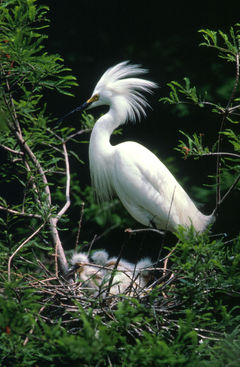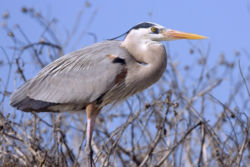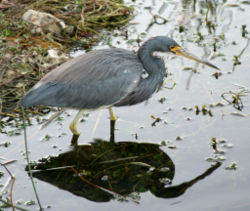| Herons | ||||||||||
|---|---|---|---|---|---|---|---|---|---|---|

Snowy Egret, Egretta thula. Note the
chicks in the nest.
|
||||||||||
| Scientific classification | ||||||||||
|
||||||||||
| See text. |
The herons are wading birds in the Ardeidae family. Some are called egrets or bitterns instead of herons.
Within the family, all members of the genera Botaurus and Ixobrychus are referred to as bitterns, and—including the Zigzag Heron or Zigzag Bittern—are a monophyletic group within the Ardeidae. However, egrets are not a biologically distinct group from the herons, and tend to be named differently because they are mainly white or have decorative plumes.
The classification of the individual heron/egret species is fraught with difficulty, and there is still no clear consensus about the correct placement of many species into either of the two major genera, Ardea and Egretta. Similarly, the relationship of the genera in the family is not completely resolved. For example, the Boat-billed Heron is sometimes classed as a heron, and sometimes given its own family Cochlearidae, but nowadays it is usually retained in the Ardeidae.
Although herons resemble birds in some other families, such as the storks, ibises and spoonbills, they differ from these in flying with their necks retracted, not outstretched.
The members of this family are all primarily associated with wetlands, and prey on fish, frogs and other aquatic species. Some, like the Cattle Egret, also take large insects, and are less tied to watery environments. Some members of this group nest colonially in trees, others, notably the bitterns, use reedbeds.
In February 2005, the Canadian scientist Dr. Louis Lefebvre announced a method of measuring avian IQ in terms of their innovation in feeding habits. Herons were named among the most intelligent birds based on this scale, reflecting a wide variety, flexibility and adaptiveness to acquire food.
Contents |
Taxonomy
Analyses of the skeleton, mainly the skull, suggested that the Ardeidae could be split into a diurnal and a crepuscular/nocturnal group which included the bitterns. From DNA studies and skeletal analyses focusing more on bones of body and limbs, this grouping has been revealed as incorrect (McCracken & Sheldon, 1998). Rather, the similarities in skull morphology reflect convergent evolution to cope with the different challenges of daytime and nighttime feeding. Today, it is believed that three major groups can be distinguished (Sheldon et al., 2000), which are (from the most primitive to the most advanced):
- tiger herons and the boatbill
- bitterns
- day-herons and egrets, and night-herons
FAMILY ARDEIDAE
Subfamily Tigrisomatinae
- Genus
Cochlearius
- Boat-billed Heron, Cochlearius cochlearius
- Genus
Tigrisoma
- Bare-throated Tiger Heron, Tigrisoma mexicanum
Fasciated Tiger Heron, Tigrisoma fasciatum
Rufescent Tiger Heron, Tigrisoma lineatum
- Bare-throated Tiger Heron, Tigrisoma mexicanum
- Genus
Tigriornis
- White-crested Tiger Heron, Tigriornis leucolophus
- Genus
Zonerodius
- New Guinea Tiger Heron, Zonerodius heliosylus
Subfamily Botaurinae
- Genus
Zebrilus
- Zigzag Heron, Zebrilus undulatus
- Genus
Ixobrychus
- Little Bittern, Ixobrychus minutus
New Zealand Little Bittern, Ixobrychus novaezelandiae (extinct)
Cinnamon Bittern, Ixobrychus cinnamomeus
Stripe-backed Bittern, Ixobrychus involucris
Least Bittern, Ixobrychus exilis
Yellow Bittern, Ixobrychus sinensis
Schrenck's Bittern, Ixobrychus eurhythmus
Dwarf Bittern, Ixobrychus sturmii
Black Bittern, Ixobrychus flavicollis
- Little Bittern, Ixobrychus minutus
- Genus
Botaurus
- American Bittern, Botaurus lentiginosa.
Great Bittern or European Bittern, Botaurus stellaris
South American Bittern, Botaurus pinnatus
Australasian Bittern, Botaurus poiciloptilus
- American Bittern, Botaurus lentiginosa.
Subfamily Ardeinae
- Genus Zeltornis (fossil)
- Genus
Nycticorax
- Yellow-crowned Night Heron, Nycticorax violaceus
or Nyctanassa violacea
Bermuda Night Neron, Nycticorax carcinocatactes or Nyctanassa carcinocatactes (extinct)
Black-crowned Night Heron, Nycticorax nycticorax
White-backed Night Heron, Nycticorax leuconotus or Gorsachius leuconotus
Rodrigues Night Heron, Nycticorax megacephalus (extinct)
Réunion Night Heron, Nycticorax duboisi (extinct)
Mauritius Night Heron, Nycticorax mauritianus (extinct)
Ascension Night Heron, Nycticorax olsoni (extinct)
- Yellow-crowned Night Heron, Nycticorax violaceus
or Nyctanassa violacea
- Genus
Gorsachius
- Nankeen Night Heron or Rufous Night Heron,
Gorsachius caledonicus or Nycticorax caledonicus
White-eared Night Heron, Gorsachius magnificus
Japanese Night Heron, Gorsachius goisagi
Malayan Night Heron, Gorsachius melanolophus
- Nankeen Night Heron or Rufous Night Heron,
Gorsachius caledonicus or Nycticorax caledonicus
- Genus
Butorides
- Green Heron or Green-backed Heron, Butorides
virescens
Striated Heron, Butorides striatus or Ardea striatus
- Green Heron or Green-backed Heron, Butorides
virescens
- Genus
Agamia
- Agami Heron, Agamia agami
- Genus
Philherodias
- Capped Heron, Pilherodius pileatus
- Genus
Ardeola
- Indian Pond Heron, Ardeola grayii
Squacco Heron, Ardeola ralloides
Chinese Pond Heron, Ardeola bacchus
Javan Pond Heron, Ardeola speciosa
Madagascar Pond Heron, Ardeola idae
Rufous-bellied Heron, Ardeola rufiventris
- Indian Pond Heron, Ardeola grayii
- Genus
Bubulcus
- Cattle Egret, Bubulcus ibis or Ardea ibis
- Genus Proardea (fossil)
- Genus
Ardea
-
Great Blue Heron, Ardea herodias
 Great Blue Heron, Ardea herodias
Great Blue Heron, Ardea herodias - Grey Heron, Ardea cinerea
Goliath Heron, Ardea goliath
Cocoi Heron, Ardea cocoi
White-necked Heron or Pacific Heron, Ardea pacifica
Black-headed Heron, Ardea melanocephala
Madagascar Heron, Ardea humbloti
White-bellied Heron, Ardea insignis
Great-billed Heron, Ardea sumatrana
Purple Heron, Ardea purpurea
Great Egret or Great White Egret, Ardea alba
Pied Heron, Ardea picata or Egretta picata
Intermediate Egret, Ardea intermedia or Egretta intermedia
Swinhoe's Egret or Chinese Egret, Ardea eulophotes or Egretta eulophotes
-
Great Blue Heron, Ardea herodias
- Genus
Syrigma
- Whistling Heron, Syrigma sibilatrix
- Genus
Egretta
- Little Egret, Egretta garzetta or Ardea garzetta
Snowy Egret, Egretta thula
Reddish Egret, Egretta rufescens
Slaty Egret, Egretta vinaceigula
Black Heron, Egretta ardesiaca
Tricolored Heron or Louisiana Heron, Egretta tricolor -
 Tricolored Heron or Louisiana Heron, Egretta tricolor
Tricolored Heron or Louisiana Heron, Egretta tricolor - White-faced Heron, Egretta novaehollandiae or
Ardea novaehollandiae
Little Blue Heron, Egretta caerulea
Eastern Reef Egret, Egretta sacra or Ardea sacra
Western Reef Heron, Egretta gularis
- Little Egret, Egretta garzetta or Ardea garzetta
- Genus undetermined
- Easter Island Heron, Ardeidae gen. et sp. indet. (prehistoric)
Other prehistoric and fossil species are included in the respective genus accounts.
The night herons could warrant separation as subfamily Nycticoracinae, as it was traditionally done. However, the position of some genera (e.g. Butorides or Syrigma) is unclear at the moment, and molecular studies have until now suffered from a small number of studied taxa. Especially the relationship among the ardeidine subfamily is very badly resolved. The arrangement presented here should be considered provisional.
References
- McCracken, Kevin G. & Sheldon, Frederick H. (1998): Molecular and osteological heron phylogenies: sources of incongruence. Auk (journal) 115: 127–141. PDF fulltext
- Sheldon, Frederick H.; Jones, Clare E. & McCracken, Kevin G. (2000): Relative Patterns and Rates of Evolution in Heron Nuclear and Mitochondrial DNA. Molecular Biology and Evolution 17(3): 437–450. PDF fulltext
External links
- Heron videos on the Internet Bird Collection




 216.73.216.91
216.73.216.91 User Stats:
User Stats:
 Today: 0
Today: 0 Yesterday: 0
Yesterday: 0 This Month: 0
This Month: 0 This Year: 0
This Year: 0 Total Users: 117
Total Users: 117 New Members:
New Members:
 216.73.xxx.xx
216.73.xxx.xx
 Server Time:
Server Time: